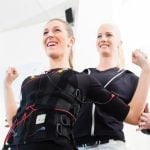What is functional fitness exercises? Functional fitness has become a popular term in the world of exercise and physical training, but what does it actually mean? In this article, we will explore the concept of functional fitness exercises and their impact on overall health and well-being. From defining the concept to uncovering its benefits and principles, we will delve into the world of functional fitness and how it differs from traditional exercise.
Functional fitness exercises focus on training the body to perform everyday activities with efficiency and ease. This type of training emphasizes movements that are practical and mimic real-life activities, such as bending, lifting, pushing, pulling, and reaching. The goal is to improve strength, flexibility, balance, coordination, and endurance in a way that translates to improved functionality in daily life.
Beyond just physical benefits, functional fitness exercises also offer mental advantages. By engaging multiple muscle groups and promoting coordination and balance, these exercises can enhance cognitive function and promote mental sharpness. Additionally, the variety of movements involved in functional fitness can keep workouts interesting and challenging for participants.
The Benefits of Functional Fitness Exercises
Functional fitness exercises not only provide physical benefits, but also contribute to mental well-being. Both aspects play an essential role in promoting a healthy and balanced lifestyle.
Physical Benefits
Functional fitness exercises help improve muscle strength, flexibility, and endurance. The focus on movements that mimic everyday activities enables individuals to build functional strength that can be applied to real-life situations. This type of training also enhances balance and coordination, reducing the risk of falls and injuries, especially in older adults. Moreover, functional fitness workouts can lead to better posture and alignment, alleviating discomfort and pain caused by poor body mechanics.
Mental Benefits
Engaging in functional fitness exercises can have a positive impact on mental well-being. Studies have shown that regular physical activity can reduce symptoms of anxiety and depression, improve mood, and enhance cognitive function. The sense of accomplishment from mastering new movements or achieving personal fitness goals can boost self-esteem and confidence. Additionally, the social aspect of group functional fitness classes or workouts with a partner can provide emotional support and motivation.
Overall Well-Being
Incorporating functional fitness exercises into one’s routine promotes overall well-being by addressing both physical and mental health. By reaping the benefits of improved physical strength and mental resilience, individuals are better equipped to handle the challenges of daily life with confidence and vitality.
The combination of physical and mental benefits makes functional fitness exercises a valuable tool for maintaining a healthy lifestyle at any age or fitness level.
How Functional Fitness Differs From Traditional Exercise
Functional fitness differs from traditional exercise in several key ways. While traditional exercise often focuses on isolated muscle groups, functional fitness emphasizes movements that mimic everyday activities, such as pushing, pulling, lifting, and squatting. This approach to fitness aims to improve overall strength and flexibility to make daily tasks easier and reduce the risk of injury.
Another way functional fitness differs from traditional exercise is its focus on multi-joint movements rather than single-joint exercises. For example, a traditional bicep curl only works the bicep muscle, whereas a functional fitness exercise like a bent-over row engages multiple muscles including the back, shoulders, and arms. This comprehensive approach to training not only builds strength but also improves coordination and stability.
Furthermore, functional fitness often incorporates elements of balance, agility, and core stability into workouts. These components are essential for everyday activities such as walking, bending, carrying groceries, or playing sports. By incorporating these aspects into training routines, functional fitness better prepares individuals for real-life movements and challenges.
| Aspect | Difference |
|---|---|
| Muscle Focus | Focuses on overall movement patterns rather than isolated muscle groups |
| Movements | Utilizes multi-joint exercises instead of single-joint exercises |
| Additions |
The Key Principles of Functional Fitness Training
Functional fitness training is based on several key principles that set it apart from traditional exercise methods. The first principle is that functional fitness aims to mimic real-life movements and activities. This means incorporating exercises that improve strength, flexibility, and balance to better perform daily tasks.
Another important principle of functional fitness is the focus on multiple muscle groups and joint movements. Rather than isolating specific muscles, functional fitness exercises engage various muscle groups simultaneously, promoting overall body strength and coordination.
Additionally, functional fitness emphasizes the use of equipment such as kettlebells, resistance bands, and stability balls to add an element of instability to workouts. By challenging balance and core stability, these tools help improve overall physical function.
Overall, the key principles of functional fitness training revolve around improving an individual’s ability to perform everyday activities with ease and reducing the risk of injury in day-to-day life. By incorporating these principles into a regular exercise routine, individuals can experience improved overall functionality and well-being.
| Principle | Description |
|---|---|
| Real-Life Movements | Incorporating exercises that mimic daily activities |
| Engaging Multiple Muscle Groups | Focusing on overall body strength and coordination |
| Use of Unstable Equipment | To challenge balance and core stability for improved physical function |
Types of Functional Fitness Exercises
Functional fitness exercises focus on movements that mimic everyday activities and use equipment that improves strength, balance, coordination, and endurance. These exercises are designed to help individuals perform better in their daily activities and reduce the risk of injury. There are various types of functional fitness exercises that incorporate different movements and equipment.
Bodyweight Exercises
One of the most common types of functional fitness exercises is bodyweight exercises. These include squats, lunges, push-ups, planks, and burpees. Bodyweight exercises help improve strength and stability while also enhancing flexibility and mobility. They require little to no equipment, making them accessible for people of all fitness levels.
Functional Training Equipment
Functional fitness exercises often incorporate equipment such as resistance bands, kettlebells, medicine balls, TRX suspension trainers, and balance boards. These tools challenge the body to stabilize itself during movement, improving overall balance and coordination. Using functional training equipment can also enhance muscle strength and endurance while engaging multiple muscle groups simultaneously.
Functional Movements
Functional fitness exercises focus on movements that involve multiple joints and muscles working together in a coordinated manner. Examples of functional movements include pushing, pulling, bending, twisting, squatting, lifting, reaching, and carrying. These movements simulate the actions required for daily tasks such as lifting groceries or bending to pick up objects from the floor.
By incorporating a variety of functional fitness exercises into a workout routine that targets different movements using various equipment options can help individuals improve overall physical function in their daily lives while reducing the risk of injury.
The Importance of Functional Fitness for Everyday Life
Functional fitness is not just about building strength and endurance, it’s about preparing your body to perform everyday activities with ease. This type of exercise focuses on movements that mirror those we use in our daily lives, such as squatting, lifting, pushing, pulling, and twisting. By incorporating functional fitness exercises into your routine, you can improve your physical capabilities for tasks like carrying groceries, lifting heavy objects, or playing with your children.
One of the key benefits of functional fitness for everyday life is injury prevention. By targeting multiple muscle groups and focusing on stability and mobility, these exercises can help strengthen the body in a way that reduces the risk of strains and sprains during normal activities. This is especially important as we age, as maintaining functional fitness can help preserve independence and quality of life.
In addition to physical benefits, functional fitness exercises also have a positive impact on mental well-being. Performing movements that mimic real-life activities can boost confidence and self-esteem by demonstrating how capable your body is.
This empowerment can translate to improved performance in everyday tasks and a greater sense of overall well-being. Overall, the importance of functional fitness for everyday life cannot be overstated-it provides both physical and mental advantages that contribute to a healthier, more active lifestyle.
Common Myths and Misconceptions About Functional Fitness
When it comes to functional fitness, there are several myths and misconceptions that may prevent individuals from fully embracing this type of exercise regimen. Let’s take a closer look at some of these common myths and clear up any misunderstandings:
Some of the most common myths and misconceptions about functional fitness include:
- Functional fitness is only for athletes or gym enthusiasts
- Functional fitness doesn’t provide a challenging workout
- Functional fitness requires expensive equipment or gear
One of the most prevalent myths about functional fitness is that it’s only suitable for athletes or individuals who frequent the gym. In reality, functional fitness exercises can be tailored to accommodate people of all ages and fitness levels, making it accessible to everyone.
Another misconception is that functional fitness doesn’t provide a challenging workout. On the contrary, functional fitness exercises can be highly intense and effective in improving overall strength, flexibility, and endurance.
Furthermore, many people believe that practicing functional fitness requires expensive equipment or gear. However, functional fitness can be performed using simple bodyweight exercises or minimal equipment, making it a cost-effective option for those looking to improve their physical health and wellness.
By debunking these common myths and misconceptions about functional fitness, individuals can gain a better understanding of what this exercise approach truly entails and how it can benefit them in their everyday lives.
How to Get Started With Functional Fitness
If you’re new to functional fitness, getting started can feel overwhelming. However, with the right tips and guidance, beginners can ease into this style of training and begin reaping its many benefits. Here are some tips for beginners looking to get started with functional fitness:
1. Start slow: It’s important to ease into functional fitness exercises, especially if you’re new to working out or have been relatively sedentary. Begin with simple movements and low resistance, gradually increasing intensity as your strength and stamina improve.
2. Focus on form: Functional fitness places a strong emphasis on proper form and technique. Before adding weight or increasing difficulty, make sure you’ve mastered the proper form for each exercise to avoid injury and maximize effectiveness.
3. Seek professional guidance: Consider working with a personal trainer or joining a beginner-friendly class to learn the basics of functional fitness from a knowledgeable instructor. They can provide personalized guidance, ensure proper technique, and help you design a program that aligns with your goals.
Remember that consistency is key when it comes to any fitness routine, including functional fitness. While it may be challenging at first, sticking with it will yield significant improvements in overall strength, flexibility, and mobility – all essential components of functional fitness.
Success Stories
In conclusion, functional fitness exercises have been proven to not only improve physical strength and endurance but also contribute to mental well-being. The success stories of individuals who have transformed their lives through functional fitness are a testament to the effectiveness of this type of training. These real-life examples provide motivation and inspiration for those who may be considering incorporating functional fitness into their exercise routine.
By focusing on movements that mimic everyday activities, functional fitness exercises help individuals build strength and flexibility that is applicable to their daily lives. Whether it’s lifting groceries, playing with children, or simply maintaining balance and stability, the benefits of functional fitness extend far beyond the walls of a gym. This practical approach to exercise makes it more relevant and sustainable for many individuals, contributing to long-term health and wellness.
It is important for beginners to recognize that functional fitness can be adapted to any fitness level or age group. With proper guidance from certified trainers or instructors, anyone can start incorporating functional fitness exercises into their routine. The key is to start gradually and focus on mastering proper form and technique before increasing the intensity. With dedication and consistency, individuals can experience the transformative effects of functional fitness in their own lives.

Passionate about providing useful information to anyone with an interest in the field of Personal Training, I strive to pass on to our readers quality information and to answer any questions about Personal Trainers, the work they do and how to become one.





